Are you still unsure whether AnyDesk or TeamViewer is the right remote desktop software for your needs? In this article, we pit TeamViewer and AnyDesk, along with their respective single-user and team plans, to help you pick the best remote desktop tool for work productivity.
- Pinpoint TeamViewer and AnyDesk differences that will help you discern which one’s better for personal or business IT infrastructure management.
- Discover the main features and functionalities of AnyDesk and TeamViewer
- Compare AnyDesk vs TeamViewer pricing plans to find the best value for your needs.
- Be confident in choosing the optimal remote desktop platform for you.
Overview
AnyDesk
AnyDesk provides fast and secure remote desktop access for work and IT support.
AnyDesk is a secure, reliable, and fast remote desktop support solution made to connect computers and devices remotely with low latency. This app can support personal access, team collaboration, and IT administration with its smooth user experience, quick troubleshooting, file sharing, and desktop control over LAN or Internet.
TeamViewer

TeamViewer enables fast, secure remote access for support, meetings, and collaboration.
TeamViewer is a versatile remote connectivity program for IT support, management, and collaboration. It enables access and control of computers anytime and anywhere through secure connections. Currently, this app is extensively adopted in corporate infrastructure management and personal remote access. Some of its top features include instant remote sessions, device monitoring, multi-user support, and file transfers.
Features
For a detailed look at the performance of AnyDesk and TeamViewer, we will analyze the pricing plans for both single users and teams and what key features they offer. This comparison shows the strengths of each platform to help you decide which option better fits your remote access and support needs.
1. Remote Access & Session Management
AnyDesk offers both attended and unattended access for connecting remote devices. Setting up unattended access is easy to do, allowing users to log in and manage systems at any time, even when nobody is present on the other side. AnyDesk also includes session recording for capturing or reviewing activities for compliance checks or training sessions. That’s not all. The platform can handle multiple concurrent sessions, which means users can operate several devices all at once.
TeamViewer, like AnyDesk, provides attended and unattended access, giving users easy connections to other systems for smooth remote troubleshooting. Session recording is another similar feature on the platform that’s especially essential for saving and reviewing sessions when needed. TeamViewer also comes with multi-session support for running multiple concurrent sessions within a tabbed interface. Technicians can use this setup to work on many tasks at the same time.
2. Collaboration & File Sharing
With its drag-and-drop feature, AnyDesk makes file transfer fast and secure, allowing users to move data between local and remote systems. Remote printing is another function of the software, letting users print files from a remote system on a local printer. Effective collaboration is also possible with AnyDesk, thanks to its session chat and interactive annotations for exchanging messages and providing on-screen guidance to clients or team members during assistance.
Similarly, TeamViewer brings file transfer capabilities to ensure sending files between devices goes without interruption. This app features drag-and-drop functionality and clipboard synchronization, too, to facilitate the sharing of materials during a session. Remote printing is also available on the platform, and this option lets technicians output files from afar to local printers. For collaboration, technicians and users can use TeamViewer’s real-time chat, voice/video calls, and quick reactions when communicating and troubleshooting.
3. Customization & Branding
AnyDesk includes a range of customization options that companies can use to tailor the remote session interface with their logo, name, and text. Personalizing the session like this improves the experience for both the technician and end-user. Making custom keyboard shortcuts is another handy function on the platform, and this helps make navigation quicker and workflows smoother.
In much the same way, TeamViewer allows agencies to apply their logo, color scheme, and personalized text to the interface using branding customization. With this feature, organizations can keep their brand consistent during remote interactions. Beyond interface branding, TeamViewer has advanced customization designed to make remote sessions look consistent and professional.
4. Performance & Ease of Use
As a lightweight software, AnyDesk uses minimal system resources and is easy to install. It also delivers low-latency performance, keeping remote connections stable even with slow internet. On top of that, both technicians and end-users don’t need training to get around the platform, thanks to its user-friendly interface. That’s why AnyDesk is excellent for anyone seeking simplicity and efficiency in remote access.
TeamViewer is a feature-rich platform guaranteeing fast, secure connections. Its wide range of tools may take users some time to master all, but each one is tailored for professional use. In addition to its extensive toolset, TeamViewer handles low-bandwidth performance well, although some minor lag may still occur at times. Complementing this, the intuitive interface makes the platform easy enough for solo technicians and small teams to explore. But it can overwhelm users looking for only the basics. Overall, TeamViewer balances speed and complexity to give professionals advanced capabilities while staying easy for general users.
5. Team & Device Management
AnyDesk provides powerful device management tools ideal for controlling multiple devices from a single dashboard. Administrators can add, track, and configure devices for unattended access, simplifying the supervision of remote sessions and proper control over who can access them. Alongside unattended access, the software’s role-based permissions let teams assign roles and regulate access. This setup helps technicians assign remote sessions to the right team members, ensuring tasks are handled efficiently.
Following a similar approach, TeamViewer features a complete device management suite, which makes it easier to monitor, control, and access remote devices across multiple systems. In addition, the platform is designed with role-based user management for administrators to use for assigning permissions according to each technician’s responsibilities. To further enhance collaboration, TeamViewer offers multi-user support so that team members can work on a single device at once, while its device groups simplify organizing and managing numerous devices across the organization.
Feature Comparison: AnyDesk and TeamViewer
| Feature | AnyDesk | TeamViewer |
|---|---|---|
| Mobile Access | (including mobile-to-mobile) | |
| File Transfer | ||
| Concurrent Sessions | Solo: 1, Standard: multiple | Business: up to 3, Premium: 1 session |
| Session Transfer | ||
| Session Recording | ||
| Real-time Chat | ||
| Remote Printing | ||
| Audio Support | ||
| Device & User Management | Standard and above | Business and above |
| USB Sharing |
Interface Comparison
AnyDesk has a fast and intuitive interface for quick remote access. Many new users find this platform easy to use. It also works well even with slow Internet or low bandwidth.
Meanwhile, TeamViewer provides more features and options for device control and teamwork. The layout is detailed, which suits IT teams and businesses. However, learning to use TeamViewer can be time-consuming.
As of September 2025, the latest license versions for AnyDesk and TeamViewer are:
Operating System Support
Before you pick a remote desktop software, you must first check if it works with your devices. The table below compares OS compatibility and support for AnyDesk Solo and Standard with TeamViewer Premium and Business. Both present major platforms so you can discern the differences between some specialized systems.
| Operating System | AnyDesk Solo & Standard | TeamViewer Premium & Business |
|---|---|---|
| Windows | ||
| macOS | ||
| Linux | ||
| Android | ||
| iOS | ||
| Chrome OS | Limited (via web client) | Limited (via web client) |
| FreeBSD | ||
| RaspberryPi | (ARM version available) |
- • AnyDesk and TeamViewer can operate on major desktop and mobile platforms in their main plans.
- • Chrome OS is accessible via web clients for both programs.
- • TeamViewer’s device management tools focus more on common platforms found in corporate settings.
Security
Security matters most with remote desktop tools since they access sensitive and vital devices and data. AnyDesk and TeamViewer both use strong security to keep your connections safe and private. The table below compares security features in AnyDesk Solo and Standard with TeamViewer Premium and Business.
AnyDesk Solo and Standard Security
- • TLS 1.2 Encryption: All data sent during sessions is protected by strong encryption with the same sophistication applied in online banking.
- • RSA 2048 Asymmetric Key Exchange: Secures session start-up and blocks unwanted access or attacks.
- • Two-Factor Authentication (2FA): Adds an extra second step to log in for a safer account access.
- • Access Permissions: Control what remote users can do, even at a granular level, such as view, transfer files, or take control.
- • Whitelisting: Only trusted or designated devices can access sessions, as unauthorized connections are blocked promptly.
- • Session Logging: Keeps records of all sessions to track activity and assist in audits.
- • GDPR Compliance: Upholds user data privacy in accordance with EU regulations.
TeamViewer Premium and Business Security
- • AES 256-bit Encryption: All-around top-level encryption for all sessions and data.
- • Two-Factor Authentication: Every user must use a second code via an authenticator application or SMS for extra account access security.
- • One-Time Passwords: Use time-limited passwords to enter sessions.
- • Device Authorization: Only approved devices can log in to ensure blocking of unwanted access.
- • Session Recording and Audit Trails: Sessions are recorded, coupled with reports to help with audit purposes.
- • Compliance Certifications: TeamViewer meets GDPR, ISO 27001, SOC 2, HIPAA, and other key standards.
- • Advanced Access Controls: Manage users and devices, setting roles and permissions as needed.
Usage Scenarios
Whether it is for personal or official business use, you must pick a remote desktop software that will meet your specific requirements. Hence, choose a tool that works for different tasks, like AnyDesk and TeamViewer. Below is a guide on which software fits best for various use cases.
AnyDesk Usage by Plan
- • Solo License: Best for personal use. Connect to home or work devices with basic remote control tools.
- • Standard Plan: Suits small businesses. Handle more sessions, use admin controls, and manage devices.
- • Advanced & Ultimate Plans: Great for bigger needs. Get custom branding, faster help, and more ways to connect other tools.
- • Enterprise Support: Meant for large companies. Offers full remote access, stronger security, API use, and special support.
TeamViewer Usage by Plan
- • Remote Access License: Best for individuals who need simple, secure access to personal or home devices.
- • Business License: Fits small businesses, with up to three users working simultaneously and tools to manage users and computers.
- • Premium, Corporate, and Tensor Plans: Made for advanced needs and bigger teams. These plans add better monitoring, detailed reports, support for more users, and features that help companies grow.
- • Tensor Plan: Built for very large organizations. Offers global access, strong security, and options to connect with other business systems.
Integration
Smooth integration of your remote desktop software with your current tools can make your work faster and more efficient. Here’s how AnyDesk and TeamViewer compare when it comes to integrations in their basic and mid-level plans.
| Integration Feature | AnyDesk Solo | AnyDesk Standard | TeamViewer Business | TeamViewer Premium | |
|---|---|---|---|---|---|
| 1. | API Access | Basic API access for automation | Basic API access for integrations | Advanced API with extended features | |
| 2. | ITSM (IT Service Management) Integration | Limited integration (basic support tickets) | Full ITSM integrations such as ServiceNow, Jira Service Desk | ||
| 3. | CRM (Customer Relationship Management) Integration | Limited support via third-party tools | Native integrations with Salesforce, Zoho CRM | ||
| 4. | Custom Workflow Automation | Limited scripting/automation | Basic workflow automation | Advanced workflow automation tools | |
| 5. | Third-Party App Compatibility | Minimal | Basic compatibility (e.g., Slack notifications, Zapier basic) | Basic compatibility (e.g., Microsoft Teams, Zendesk) | Wide range including Microsoft Teams, Zendesk, Salesforce, Slack, and Zapier |
| 6. | White-labeling & Branding | ||||
| 7. | Admin Console / User Management | ||||
| 8. | Integration with Ticketing Systems | Limited integration (e.g., Zendesk, Freshdesk) | Full support and seamless integration | ||
| 9. | SDKs or Developer Tools | Limited | Limited | Extensive developer tools |
AnyDesk Solo & Standard Integration
- • Solo: Features very limited integration options. It works mainly as a standalone remote access tool without API or connections to other software.
- • Standard: Offers basic API access, so you can set up simple automations or link with existing IT systems. More advanced integrations are only available in higher plans (Advanced and Ultimate).
TeamViewer Premium & Business Integration
- • Premium: Comes with broader and more flexible integration features, such as APIs. You can connect TeamViewer with IT service management (ITSM) and CRM platforms.
- • Business: Supports basic API access and some third-party tool connections, which is useful for small teams. More powerful integrations are found in the Corporate and Tensor plans.
Pricing
Price is always a crucial consideration when you pick a remote desktop application. AnyDesk and TeamViewer both have tiered pricing options for individuals, small teams, or large companies. Each plan’s price aligns with its unique features and user limits. Review the overview and comparison table below to choose the best option.
AnyDesk Pricing Plans
- • Free: Use at no cost for personal use, albeit with limited features.
- • Solo — $22.90/month: For one user. Includes unlimited devices, session recording, file transfer, and mobile use.
- • Standard — $35.90/month: Allows more than one session at once. Includes admin tools, device management, and remote control from one mobile to another.
- • Advanced — $79.90/month: Adds custom branding, priority support, and extensive admin options for growing companies.
- • Ultimate — Custom pricing: A top-tier plan for large businesses. Offers API accessibility, more integrations, and dedicated support.
TeamViewer Pricing Plans
TeamViewer offers several license options suitable for personal use to large-scale enterprises:
- • Free (Personal Use Only): Absolutely cost-free for non-commercial use but with limited features.
- • Single User (Business) — $24.90/month: One license with one session at a time. Includes device and user management for small teams.
- • Multi-User (Premium) — $50.90/month: Supports up to three sessions. Adds better device monitoring and reporting.
- • For Teams (Corporate) — $102.90/month: Can handle up to three sessions at once. Offers advanced device tools, reporting, and service case management.
- • Tensor — Custom pricing: A plan for large companies. Highlights top security and plenty of advanced integrations.
Pricing Comparison Table: AnyDesk vs TeamViewer
| Pricing plans | AnyDesk | TeamViewer |
|---|---|---|
| Free Trial | 14-Days | 14-day commercial trial |
| Free Personal Version | ||
| Level 1 | $14.90/month | $24.90/month |
| Level 2 | $29.90/month | $50.90/month |
| Level 3 | $59.90/month | $102.90/month |
| Level 4 | N/A | $206.90/month |
| Level 5 | Custom pricing (Ultimate) | Custom – Tensor/Enterprise |
Possible Errors and Restrictions
AnyDesk and TeamViewer are both robust and reliable remote desktop access, but still have flaws. Users might encounter technical problems based on their plan, network, or device type. Familiarity with these limits can set clear expectations of the tools’ capabilities and solve issues faster.
AnyDesk
- • Connection issues: Low-bandwidth or unstable internet can cause lag or interrupted sessions.
- • Feature limits: Advanced tools like multi-session, branding, or full device management require higher, more costly plans.
- • Free plan limits: The free version blocks business use and may limit session time.
- • Compatibility: Most devices work, but some old or rare systems may not get full support.
- • Network restrictions: Firewalls or strict networks may block AnyDesk. Manual setup may be needed.
- • Session limits: The Solo plan allows only one session at a time. More sessions need a higher plan.
TeamViewer
- • Commercial use check: The free plan is only for personal use. Business use may end sessions early.
- • Session limits: Business plans limit the number of active sessions. More users may need an upgrade.
- • Network blocks: Firewalls or proxies can block TeamViewer. Some networks need special settings.
- • Updates: Forced updates may stop sessions or require restarts, which can slow down work.
- • Compatibility: Some old systems or special devices may not work fully.
- • Feature access: Premium or higher plans unlock advanced device tools and monitoring.
Pros And Cons
The advantages and drawbacks of AnyDesk and TeamViewer are summarized in the tables below. This comparison is designed to help you evaluate their features, guiding you toward an informed purchasing decision. In this section, we emphasize the pros and cons of both platforms based on authentic user reviews. These insights come directly from feedback provided by individuals with hands-on experience using each solution.
- Very small installation file;
- Fast navigation thanks to low-latency;
- No time caps for sessions;
- Responsive UI and numerous keyboard shortcuts;
- Available for all major mobile OS/platforms.
- Glitches while using the copy-paste feature;
- Times when remote desktop resolution fluctuates;
- Mandatory installation required to access system files.
TeamViewer:
"TeamViewer is unbeatable for remote connections"— Read full review
- Free for non-commercial use;
- Multi-platform operating system support including for IoT devices;
- Enables training sessions for teams of up to 25 members;
- Drag-and-drop file sharing across multiple locations;
- Status to indicate if a device is being remotely accessed;
- TeamViewer is easy to install and update with no router configuration needed;
- Chat, video, and voice over IP communication options;
- Share application windows or complete desktops;
- Superior customer support.
- Requires a fast and continuous Internet connection;
- Can be costly for commercial purposes that require licenses;
- Must be updated to the same version on both sides of the connection;
- Cannot share large files;
- Is not compatible with proxy servers.
HelpWire: A Strong Alternative to AnyDesk and TeamViewer
What Is HelpWire?
HelpWire is an innovative and flexible remote desktop tool made for IT support and device access. The software focuses on speed, ease of use, and strong security. Companies can use HelpWire as a simpler, cheaper choice than TeamViewer or AnyDesk.
Key Features:
-
Fast remote access:Enjoy low-latency remote sessions whether on fast or slow Internet connections.
-
Cross-platform support:
-
Session recording and reporting:Record sessions for training, audits, or standard compliance.
-
File transfer and chat:Share files and communicate securely during a remote session.
-
No client install needed:Launch remote connection with a web link. Client app installation is not required to initiate the connection.
-
Even without end-user interaction, you can set up devices for secure access at any time.
-
Features End-to-end encryption, two-factor login, and Auth0.
HelpWire offers all core remote access features with a modern look. This tool fits companies that want a flexible, safe, and easy way to support users.
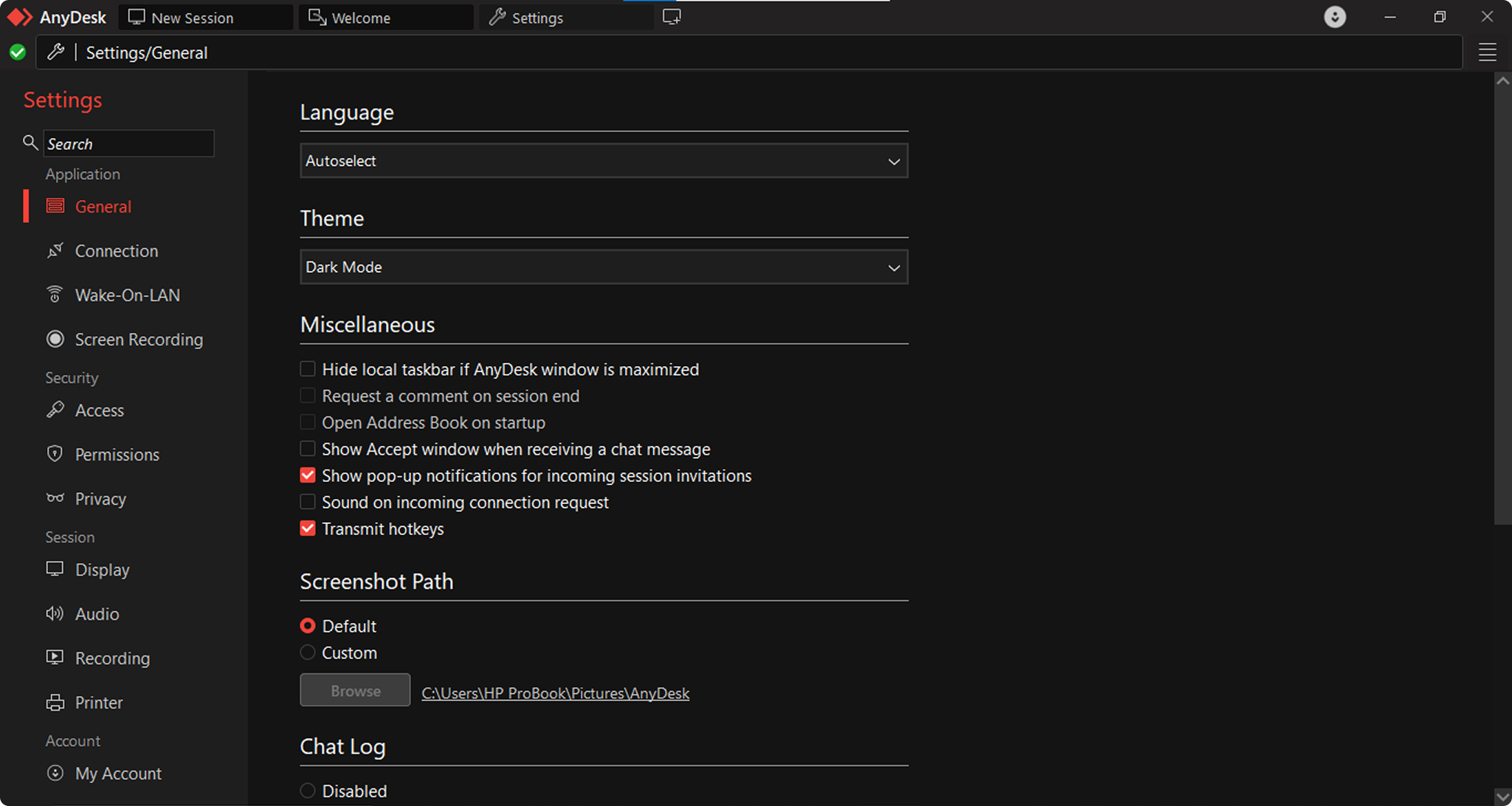
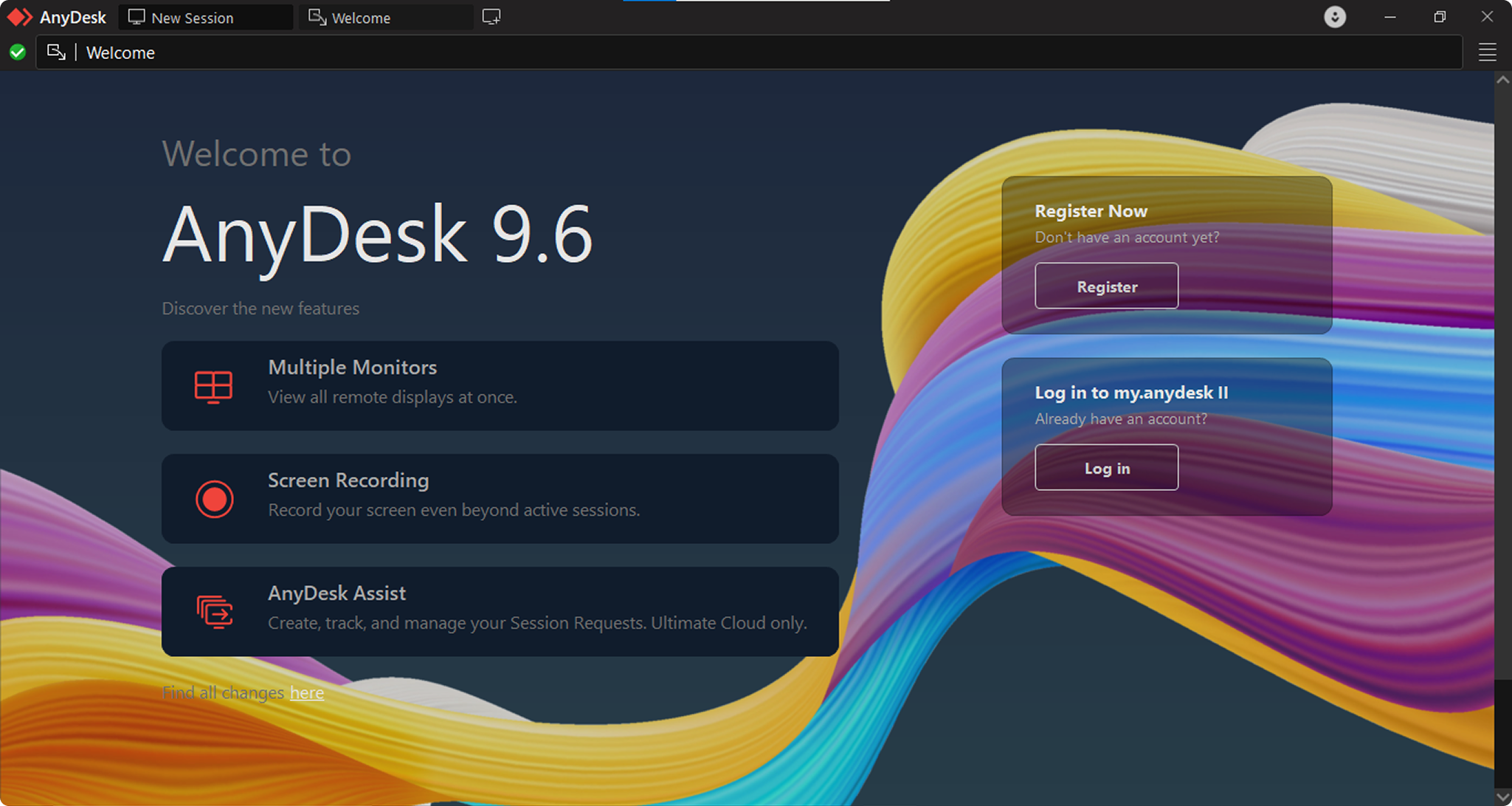
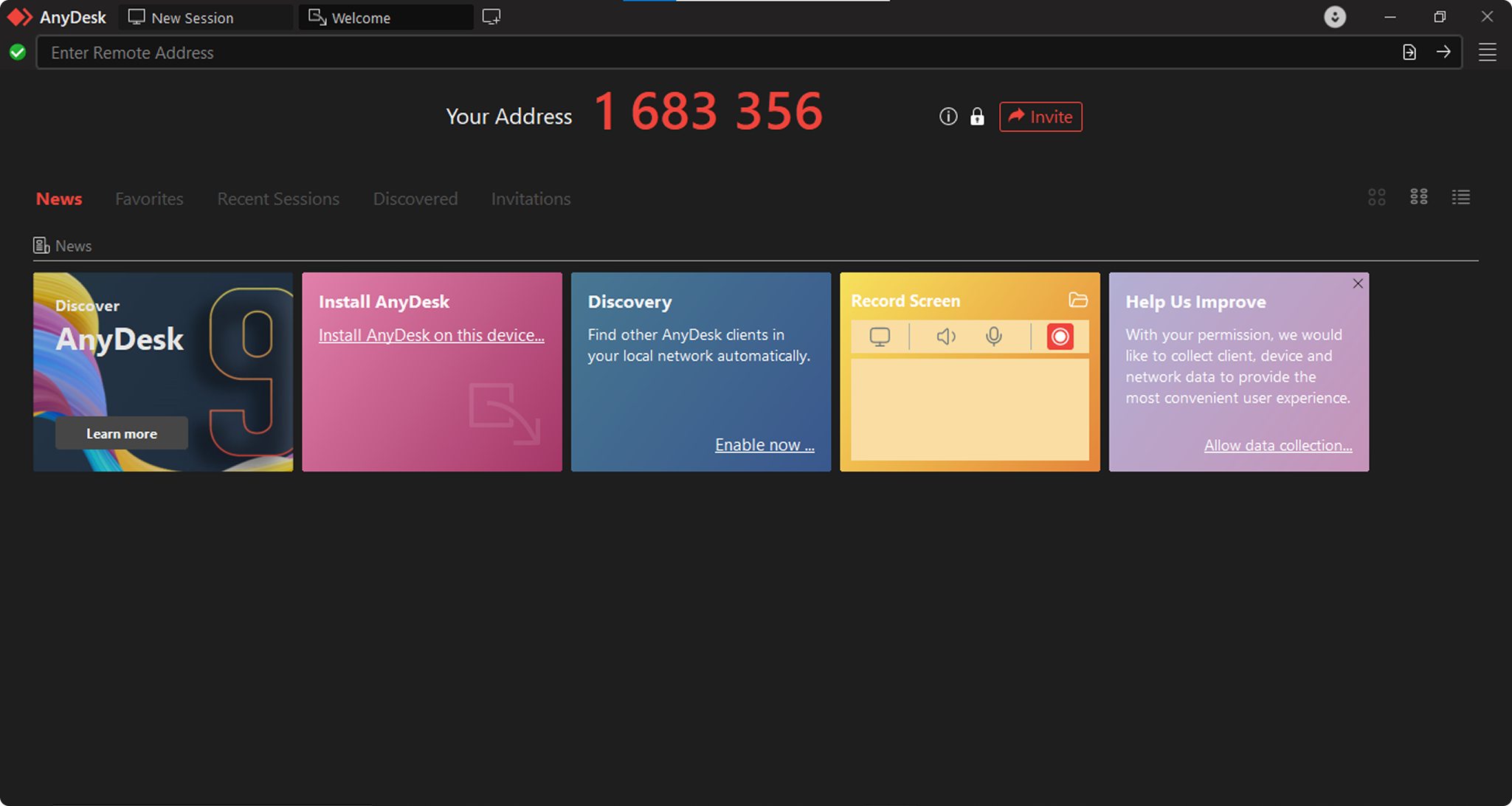
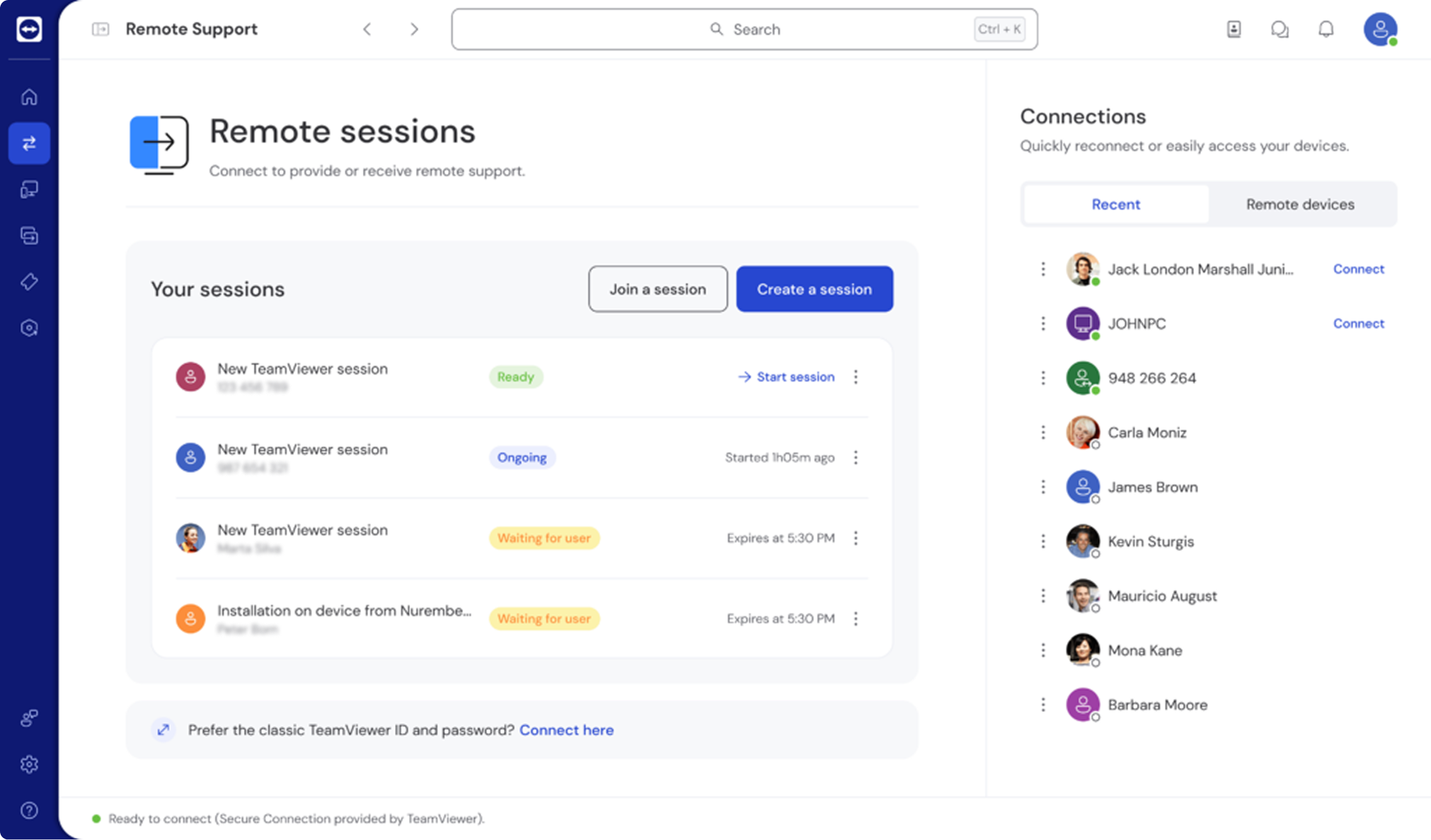
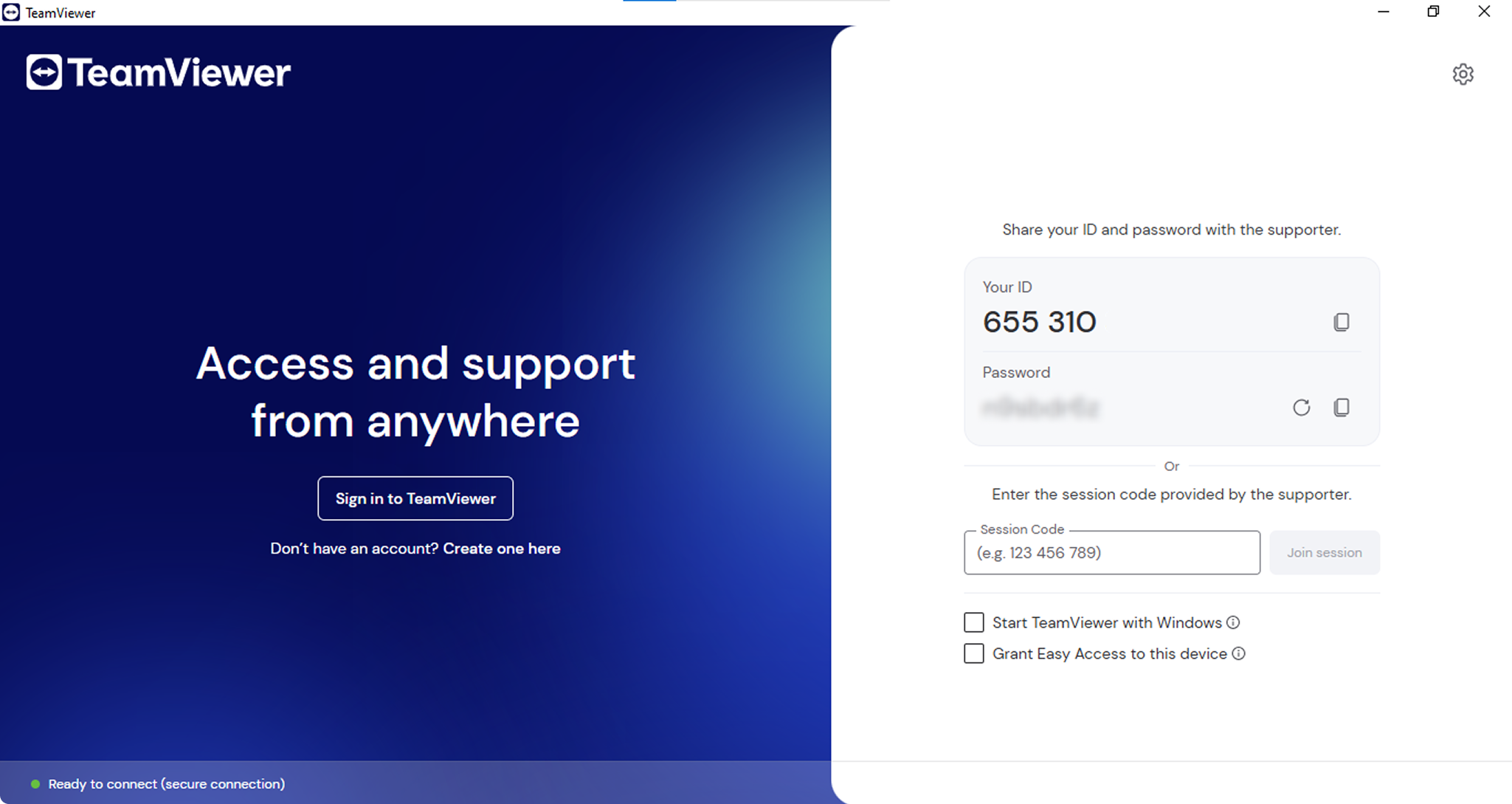

AnyDesk: